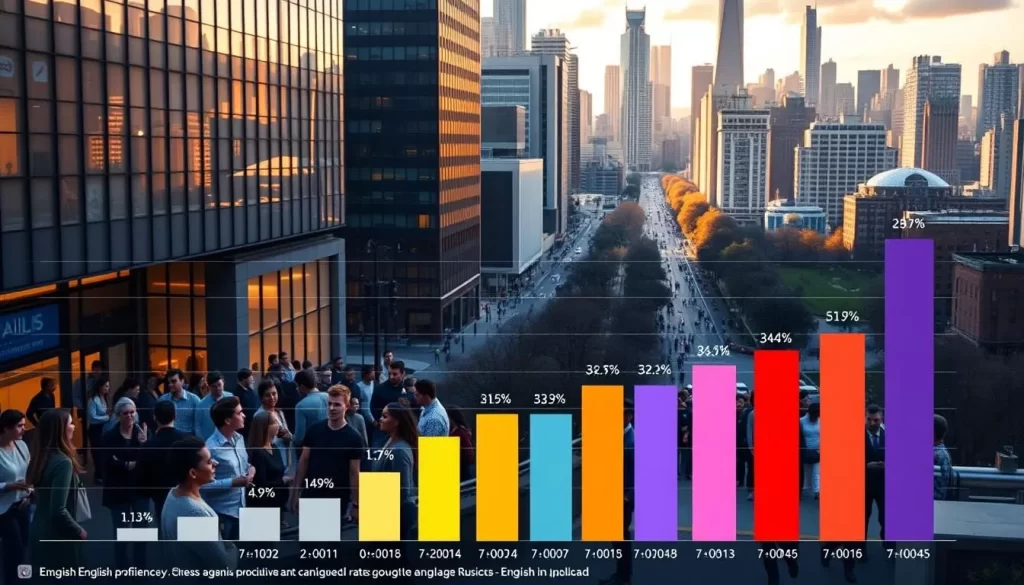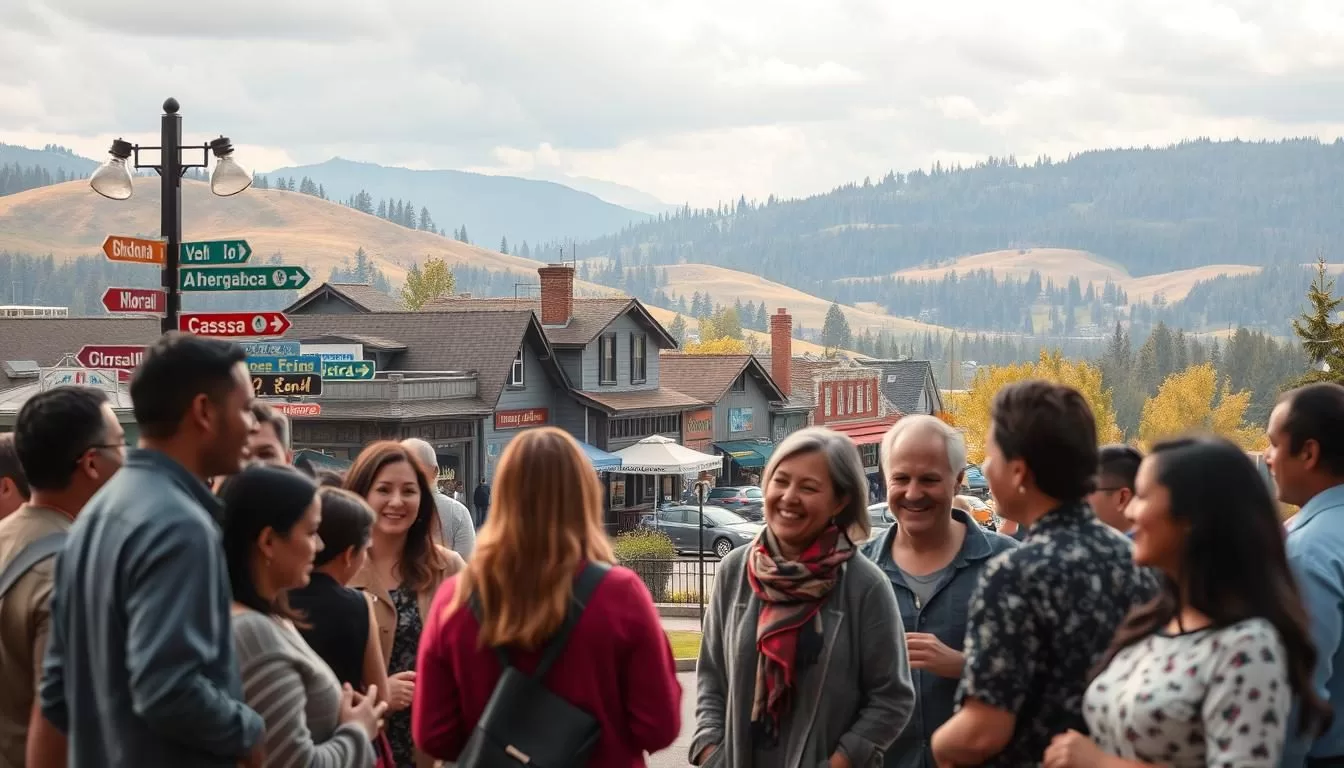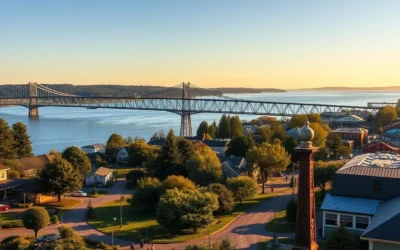When you visit or move to Oregon, understanding the linguistic landscape can significantly enhance your experience. With an estimated 4.24 million residents, the state’s language dynamics are diverse.
While the vast majority speak English, around 15.3% of persons above the age of 4 (about 648,741 Oregonians) speak a language other than English at home. This diversity reflects Oregon’s immigration history and multicultural heritage.
As you explore Oregon, you’ll discover vibrant multicultural communities and a range of languages being spoken. This article will guide you through the official language status, the most commonly spoken languages, and how language diversity varies across different regions.
The Linguistic Makeup of Oregon Today
As you explore Oregon’s linguistic landscape, you’ll discover a diverse tapestry of languages spoken across the state. The population of Oregon is linguistically diverse, with a significant number of residents speaking languages other than English at home.
English as the Predominant Language
You’ll find that English remains the dominant language across Oregon, with the vast majority of residents using it as their primary means of communication. In fact, English is the primary language used in most aspects of life in Oregon, from education to business and government services.
The prevalence of English is evident in daily life, with most people in Oregon relying on it for communication. This widespread use of English reflects the state’s cultural and social fabric.
Language Diversity Statistics
When examining the data on language diversity, you’ll notice that approximately 15.3% of residents over the age of 4 (about 648,741 people) speak a language other than English at home. This statistic highlights the linguistic diversity within the state.
- The language diversity in Oregon varies by region, with urban areas like Portland showing greater linguistic variety than rural communities.
- About 6.21% of Oregon’s population (around 263,313 residents) have limited English proficiency, indicating a need for linguistic support services.

Oregon’s linguistic diversity presents both opportunities and challenges for community integration, education systems, and public services. Understanding this diversity is crucial for effectively serving the state’s population.
How Immigration Shaped Oregon’s Language Landscape
As you explore Oregon’s linguistic diversity, you’ll discover how immigration has played a pivotal role in shaping the state‘s language landscape. The influx of people from various parts of the world has contributed to the rich linguistic tapestry of the region.
Indigenous Languages and Early European Settlement
Initially, Oregon was home to indigenous peoples who spoke numerous Native American languages. When European settlers arrived, they brought English and other European languages, beginning the transformation of Oregon’s language landscape.

19th and 20th Century Immigration Patterns
The Oregon Trail, beginning in 1846, brought a steady flow of English-speaking migrants from the Midwest, establishing English as the dominant language in the territory. During this period, immigrants from Canada, Russia, Germany, and Scandinavia also arrived, contributing to the growing linguistic diversity of the region.
| Immigrant Group | Language(s) Brought | Time of Arrival |
|---|---|---|
| European Settlers | English, German, Scandinavian | Mid-1800s |
| Asian Immigrants | Chinese, Vietnamese, Korean, Japanese | Late 20th Century |
| Hispanic Population | Spanish | Late 20th Century |
Demographic Shifts Since the 1980s
Since the 1980s, you would notice significant demographic shifts as Asian immigrants arrived in greater numbers, bringing languages like Chinese, Vietnamese, Korean, and Japanese. The Hispanic population has also grown substantially, making Spanish the most commonly spoken non-English language in the state today.
Oregon, United States: Official and Widely Spoken Languages
Oregon’s linguistic landscape is characterized by a rich tapestry of languages, reflecting its cultural diversity. As you explore the languages spoken in Oregon, you’ll find that the state’s population is multilingual, with a significant number of residents speaking languages other than English at home.
Spanish: The Most Common Non-English Language
Spanish stands out as the most widely spoken non-English language in Oregon, used by approximately 353,257 residents, which is nearly 8.87% of the population. This significant presence of Spanish speakers reflects the large Hispanic community in the state.
Asian Languages: Chinese, Vietnamese, Korean and Japanese
Oregon is home to vibrant Asian language communities. Chinese, including Cantonese and Mandarin, is spoken by about 30,809 residents, making it the second most common non-English language. Vietnamese speakers form another significant community with approximately 27,353 speakers, representing nearly 0.69% of the state’s population. Other Asian languages spoken in Oregon include Korean and Japanese, contributing to the state’s linguistic diversity.
| Language | Number of Speakers | Percentage of Population |
|---|---|---|
| Chinese | 30,809 | 0.77% |
| Vietnamese | 27,353 | 0.69% |
| Korean | 11,061 | 0.28% |
| Japanese | 10,493 | 0.26% |
European Languages: Russian, German and French
European languages also have a significant presence in Oregon. Russian is spoken by around 22,754 residents, making up about 0.57% of the population. German and French (including Cajun) are also widely spoken, with approximately 14,304 and 12,407 speakers, respectively.
Other Significant Language Communities
Beyond the languages mentioned, Oregon is home to other significant language communities. Tagalog is spoken by 12,236 residents, while Austronesian languages like Ilocano, Samoan, and Hawaiian are spoken by around 9,810 residents. This diversity creates opportunities for translation and interpretation services, with professional providers offering support in over 200 languages.

The diverse language landscape in Oregon necessitates the need for translation and interpretation services across various industries, including healthcare, legal services, and education. Many businesses are also embracing website localization to better serve the diverse linguistic communities and achieve better results.
English Proficiency Across Different Language Groups
As you explore the linguistic landscape of Oregon, you’ll notice varying levels of English proficiency among different language groups. This variation is crucial for understanding the needs of Oregon’s diverse population.
Understanding Limited English Proficiency in Oregon
Approximately 6.21% of Oregon’s population, around 263,313 residents, have limited English proficiency (LEP). This means they face challenges communicating effectively in English. Understanding LEP is vital for healthcare providers, government agencies, and businesses serving Oregon’s diverse population, as it impacts the effectiveness of their services.
Languages with Highest and Lowest English Proficiency Rates
Different language groups exhibit distinct English proficiency rates. For instance, German speakers show high English proficiency, with only 9.2% reporting they speak English less than “very well.” In contrast, Vietnamese speakers have the lowest English proficiency rates, with 61.9% reporting limited English skills. The data highlights the need for targeted language services.
| Language Group | Limited English Proficiency Rate |
|---|---|
| German | 9.2% |
| French | 12.8% |
| Vietnamese | 61.9% |
| Chinese | 51.8% |

Conclusion: Navigating Oregon’s Multilingual Environment
With a multitude of languages spoken in Oregon, the need for professional language services has become increasingly vital. As you navigate the state’s diverse linguistic landscape, understanding the various language communities and their needs is crucial.
Professional translation and interpretation services are essential for effective communication across language barriers. Options include on-site, over-the-phone, and video remote interpretation, catering to different industries such as healthcare and legal sectors.
By embracing Oregon’s multilingual character, you contribute to a more inclusive environment. Industries serving the diverse population recognize the importance of localization, adapting content to resonate with different language communities. Partnering with a top-quality language services provider ensures that organizations reach a broader audience effectively.
The above is subject to change.
Check back often to TRAVEL.COM for the latest travel tips and deals.






